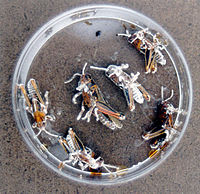
Photo from wikipedia
Metarhizium is an insect pathogenic fungus and a plant root symbiont. Here the root association patterns (rhizoplane or endophytic colonization) were analyzed in common beans (Phaseolus vulgaris) and sweet corn… Click to show full abstract
Metarhizium is an insect pathogenic fungus and a plant root symbiont. Here the root association patterns (rhizoplane or endophytic colonization) were analyzed in common beans (Phaseolus vulgaris) and sweet corn (Zea mays) using M. robertsii and M. brunneum under various vermiculite treatments (control, with sucrose, with an insect) at two time points of plant growth (10 and 20 days). We observed that M. brunneum and M. robertsii preferentially endophytically colonized the hypocotyl, however, greater rhizoplane colonization was observed at the regions proximal to the hypocotyl in both plants. Vermiculite amended with an infected insect resulted in greater endophytic and rhizoplane colonization at 20 days compared to 10 days, for both plants as well as for both Metarhizium species. Regardless of the vermiculite treatment, corn was preferentially colonized compared to bean. Sucrose amendment in the vermiculite and infected insect amended vermiculite only showed differences in rhizoplane colonization. The greatest root association occurred with M. brunneum with an infected insect and that in corn after 20 days.
Journal Title: Fungal biology
Year Published: 2020
Link to full text (if available)
Share on Social Media: Sign Up to like & get
recommendations!